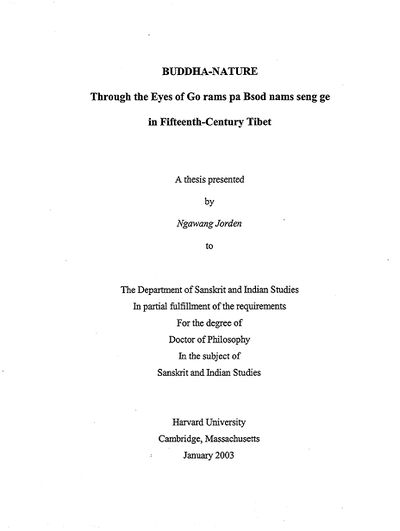Buddha-Nature: Through the Eyes of Go rams pa Bsod nams seng ge in Fifteenth-Century Tibet
< Books
| Line 58: | Line 58: | ||
**{{i|Claiming their Assertion to be in accord with Sūtras and Śāstras|103}} | **{{i|Claiming their Assertion to be in accord with Sūtras and Śāstras|103}} | ||
**{{i|Classification of Real and Imputation|110}} | **{{i|Classification of Real and Imputation|110}} | ||
| − | ***{{i|Demonstrating the Classification of Real and Imputation with Examples|110}} | + | ***{{i|Demonstrating the Classification of Real and Imputation with<br>Examples|110}} |
***{{i|Claiming All Three Tantras to be Valid|111}} | ***{{i|Claiming All Three Tantras to be Valid|111}} | ||
**{{i|Refutation of ways in which they accept the result|116}} | **{{i|Refutation of ways in which they accept the result|116}} | ||
| Line 71: | Line 71: | ||
*{{i|APPENDICES|130}} | *{{i|APPENDICES|130}} | ||
**{{i|Appendix A: The text of ''sdom gsum kha skong'''s first chapter on basis (''gzhi'') and its translation|130}} | **{{i|Appendix A: The text of ''sdom gsum kha skong'''s first chapter on basis (''gzhi'') and its translation|130}} | ||
| − | Note on the Versification | + | **{{i|Note on the Versification|130}} |
| − | The Text and Translation | + | **{{i|The Text and Translation|130}} |
| − | Appendix B: Go rams | + | **{{i|Appendix B: Go rams pa's writings|181}} |
| − | Volume | + | **{{i|Volume |182}} |
| − | Volume | + | **{{i|Volume II|187}} |
| − | Volume | + | **{{i|Volume III|188}} |
| − | Volume IV | + | **{{i|Volume IV|189}} |
| − | Volume V | + | **{{i|Volume V|194}} |
| − | List of his works arranged by | + | **{{i|List of his works arranged by subjects|198}} |
| − | On the | + | ***{{i|On the Hevajra Tantra:|198}} |
| − | On the Cakrasamvara Tantra: | + | ***{{i|On the Cakrasamvara Tantra:|200}} |
| − | On the | + | ***{{i|On the Guhyasamāja Tantra:|200}} |
| − | On the | + | ***{{i|On the Vajrabhairava Teaching:|201}} |
| − | On the Yoga Tantra: | + | ***{{i|On the Yoga Tantra:|201}} |
| − | On the | + | ***{{i|On the Prajñāpāramitā:|201}} |
| − | On the | + | ***{{i|On the Ratnagotravibhāga of Maitreya:|201}} |
| − | On the Logic and Epistemology ( | + | ***{{i|On the Logic and Epistemology (''Pramāṇa''):|202}} |
| − | On the | + | ***{{i|On the Madhyamaka Philosophy:|202}} |
| − | On the Three Sets | + | ***{{i|On the Three Sets of Vows:|202}} |
| − | On the Yoga Tantra: | + | ***{{i|On the Yoga Tantra:|203}} |
| − | Various Praises, Prayers and Answers to some Questions | + | **{{i|Various Praises, Prayers and Answers to some Questions|203}} |
| − | BIBLIOGRAPHY | + | *{{i|BIBLIOGRAPHY|208}} |
| − | Primary Sources and Translations; | + | **{{i|Primary Sources and Translations; Sūtras and Tantras|208}} |
| − | Commentaries and Philosophical Treatises | + | **{{i|Commentaries and Philosophical Treatises|209}} |
| − | Primary Sources of Works by Tibetans | + | **{{i|Primary Sources of Works by Tibetans|212}} |
| − | Secondary Sources | + | **{{i|Secondary Sources|215}} |
|AddRelatedTab=No | |AddRelatedTab=No | ||
}} | }} | ||
Revision as of 12:32, 29 May 2020
Abstract
This dissertation explores the evolving interpretation and understanding of the Buddha-nature in Fifteenth-Century Tibet, through the eyes of Go rams pa Bsod nams seng ge (1429-1489), a prominent scholar of the Sa skya school of Tibetan Buddhism. The previous work of European and American scholars in this field have led to our general understanding of Buddha-nature as an innate potential for enlightenment that lies within all sentient beings. The concept of Buddha-nature provides the primary answer to a question with which all Mahāyānists have been philosophically concerned, throughout history: are all sentient beings capable of attaining Buddhahood? The Mahāyāna, more specifically, Madhyamaka theory of Buddha-nature answers the question unequivocally: "Since all sentient beings possess Buddha-nature they are guaranteed to achieve the state of Buddhahood." This research has been mostly limited to the interpretations of Indian and Chinese texts and to a study of only certain Tibetan schools. This dissertation seeks to fill the gap in present scholarship by analyzing the systematic thought of Go rams pa, who set out to provide a critical analysis, explain the internal coherence, and map out the organization of diverse Indian and Tibetan interpretations of this complex idea. I demonstrate in two fundamental ways that Go rams pa developed an unique view of Buddha-nature in two ways: First, I explore the facts Go rams pa's interpretation of Buddha-nature that contribute to his unique perspective. Second, I analyze his opponents' views on the subject thereby illuminating its distinctive features in an historical context. Throughout this study, I deploy a comparative apparatus considering the different views that Go rams pa thought was wrong. Given this fifteenth-century debate, we realize that the understanding of Buddha-nature is subtle and complicated; yet this study is vital to explicate its implications. I conclude that according to Go rams pa, Buddha-nature is to be understood as unity of the emptiness of the mind and clarity which is the nature of mind.
| Citation | Jorden, Khenpo Ngawang. "Buddha-Nature: Through the Eyes of Go rams pa Bsod nams seng ge in Fifteenth-Century Tibet." PhD diss., Harvard University, 2003. |
|---|---|

